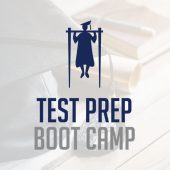A few weeks ago David Coleman, CEO of College Board, turned some heads when he told Sal Khan of Khan Academy about College Board’s plan for at-home tests if schools are closed in the Fall.
Many people acknowledged that ACT likely has similar capacity since they’ve been offering online testing for a few years now.
The comment from Coleman immediately caused a rush of the usual questions. What about equity? How will we help students who don’t have internet service at home? Will this exacerbate the disparities based on socio-economic status? What about cheating?
All of these are valid concerns. They are also relatively solvable. One of the by-products of COVID-19 has been to accelerate access. School districts like Dallas ISD have issued WiFi hotspots for students. One school district sent out school buses to specific locations equipped with mobile wifi capability. Several organizations have made refurbished Chromebooks available. Pretty awesome solutions.
Cheating is a different issue, but no less solvable. Several organizations like ProctorU and Proctorio have been working with colleges for years. They have the system down. It’s not without its horror stories, and we can debate the invasive nature that goes with those programs.
While all of those are compelling objections, they aren’t the biggest reason that at-home testing isn’t going to work.
The biggest problem isn’t about the student. It’s about the rest of the people who are at home during the test.
1st graders on a web conference
The problem occurred to me when my 1st grader was meeting online with his class. For the record, if you ever want to see “the patience of a saint” in real time, sit in on a 1st grade teacher trying to wrangle the 7 year olds into one direction for a video lesson. There’s a lot of “I’m going to put you on mute” and “Keep your microphone on mute.” During the test run the first week, one little boy discovered he could make

his classmates laugh when he turned off his camera and announced, “I’m invisible!” You can probably guess what has happened at the start of each class since.
But that hasn’t been the most frustrating. For 4 of the first 6 sessions, one parent, presumably the same parent, vacuumed the house during the online meeting. Interestingly, the 2 sessions where there was no vacuum were at a different time of day, so apparently 9:00 am is the parent’s time to vacuum the house come hell or high water. A web conference wasn’t going to get in the way of daily vacuuming.
It makes sense that it happened the first few times. If you’re the one vacuuming, you’re not going to know how it’s affecting everyone else. You’re not going to hear the distracting hum that overpowers the teacher’s lesson even more than 16 7 year olds shouting answers at the same time. The teacher sent a kindly worded email about the problem after the 3rd time it happened. It happened a 4th time.
(As a side note, he had another class while I was editing this post this morning. Guess who was back for a 5th time.)
Other complications
It hasn’t just been vacuuming. One father has had at least two high volume “discussions” with someone else. They sounded like arguments, but they weren’t in English. Maybe his native language is more effectively communicated at a higher volume. In another situation, one student’s grandparents stopped by and wanted to carry on a conversation with the student during the class.
The teacher tries to mute the students, but the particular platform they’re using allows the user to unmute themselves despite the moderator’s mute. The 7 year old who can handle Minecraft can figure out how to “unmute”. From my own experience, running an online class or webinar on your own while trying to manage the technical problems is very difficult.
Of course, taking an SAT or ACT at home will be different. It won’t have the distractions of coming from the online environment itself, but it will have complications coming from in the home. A person won’t be trying to teach a lesson while keeping the viewers engaged.
But the interruptions will still be a problem, and they could be worse than someone taking care of household chores.
AP trial run
Starting next week, College Board will be administering this year’s Advanced Placement tests online. It’s a herculean task, and they deserve plenty of credit for getting it done. Like other issues, we can argue equity or security or quality, but the idea that they’ve been able to deliver the few million tests they will over those two weeks is amazing.
Many people are looking to how the AP tests go to get a sense of how the an at-home SAT or ACT would work; however, the comparison isn’t going to be an even comparison. I’m not just talking about the fact that AP tests are all-essay while the SAT and ACT will be almost entirely multiple choice. Students might opt for a 40 or 50 minute essays at the end of the test, but those are likely on their way out.
The problem is that the at-home AP tests are much shorter than the SAT or ACT. The AP tests will be 45 minutes long. The student can probably find a place at the home to sit for an uninterrupted 45 minutes. The rest of the household can probably modify its activities for 45 minutes. The SAT and ACT take over 3 hours. Asking an entire family to put everything on hold for 3 hours isn’t practical. They might shorten the tests, but then issues of validity of the scores will come up.
Lack of control
This isn’t an equity issue, and it’s not going to be one College Board can solve. It’s a practicality issue. As humans, we find it very difficult to think beyond ourselves even when we know how important it is to do so. We know that big sister is in the office taking a test for the next 3 hours, but just really need that one thing we forgot. We’ll just slip in and grab it. And distract her. And possibly invalidate her test when the proctoring company sees another person come into the room.
This is going to be the hardest problem to solve because it is so far out of the interested parties’ control. College Board can’t control when grandma stops by for a surprise visit because she heard it was a big day or when a sibling wanders in because they need the Netflix password. The student won’t control when the parent gets a work call that they have to take even though they’ve cleared out the kitchen so the student had a good work space to use for a test.
At-home testing is fraught with far too many problems to be a practical replacement, not because we don’t have the technology to make it secure or the will to make internet access available. It won’t work because it relies on too many factors beyond the student’s control.







